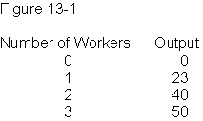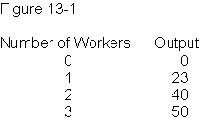True/False
Indicate whether the
sentence or statement is true or false.
|
|
|
1.
|
Total revenue equals the quantity of output the
firm produces times the price at which it sells its output.
|
|
|
2.
|
Wages and salaries paid to workers are an example
of implicit costs of production.
|
|
|
3.
|
If total revenue is €100, explicit costs are
€50, and implicit costs are €30, then accounting profit equals €50.
|
|
|
4.
|
If there are implicit costs of production,
accounting profits will exceed economic profits.
|
|
|
5.
|
When a production function gets flatter, the
marginal product is increasing.
|
|
|
6.
|
If a firm continues to employ more workers within
the same size factory, it will eventually experience diminishing marginal product
|
|
|
7.
|
If the production function for a firm exhibits
diminishing marginal product, the corresponding total cost curve for the firm will become flatter as
the quantity of output expands.
|
|
|
8.
|
Fixed costs plus variable costs equal total
costs.
|
|
|
9.
|
Average total costs are total costs divided by
marginal costs.
|
|
|
10.
|
When marginal costs are below average total costs,
average total costs must be falling.
|
|
|
11.
|
If, as the quantity produced increases, a
production function first exhibits increasing marginal product and later diminishing marginal
product, the corresponding marginal cost curve will be U-shaped.
|
|
|
12.
|
The average total cost curve crosses the marginal
cost curve at the minimum of the marginal cost curve.
|
|
|
13.
|
The average total cost curve in the long run is
flatter than the average total cost curve in the short run.
|
|
|
14.
|
The efficient scale for a firm is the quantity of
output that minimizes marginal cost.
|
|
|
15.
|
In the long run, as a firm expands its production
facilities, it generally first experiences diseconomies of scale, then constant returns to scale, and
finally economies of scale.
|
Multiple Choice
Identify the
letter of the choice that best completes the statement or answers the question.
|
|
|
16.
|
Accounting profit is equal to total revenue
minus
a. | implicit costs. | b. | variable costs. | c. | the sum of
implicit and explicit costs. | d. | explicit
costs. | e. | marginal costs. |
|
|
|
17.
|
Economic profit is equal to total revenue
minus
a. | variable costs. | b. | implicit costs. | c. | explicit
costs. | d. | marginal costs. |
|
|
|
18.
|
Nicole owns a small pottery factory. She can make
1,000 pieces of pottery per year and sell them for €100 each. It costs Nicole €20,000 for
the raw materials to produce the 1,000 pieces of pottery. She has invested €100,000 in her
factory and equipment: €50,000 from her savings and €50,000 borrowed at 10 per cent.
(Assume that she could have loaned her money out at 10 per cent, too.) Nicole can work at a competing
pottery factory for €40,000 per year. The accounting profit at Nicole's pottery factory
is
a. | €30,000. | b. | €35,000. | c. | €75,000. | d. | €70,000. | e. | €80,000. |
|
|
|
19.
|
Nicole owns a small pottery factory. She can make
1,000 pieces of pottery per year and sell them for €100 each. It costs Nicole €20,000 for
the raw materials to produce the 1,000 pieces of pottery. She has invested €100,000 in her
factory and equipment: €50,000 from her savings and €50,000 borrowed at 10 percent
(assume that she could have loaned her money out at 10 percent, too). Nicole can work at a competing
pottery factory for €40,000 per year. The economic profit at Nicole's pottery factory
is
a. | €80,000. | b. | €30,000. | c. | €75,000. | d. | €70,000. | e. | €35,000. |
|
|
|
20.
|
If there are implicit costs of
production,
a. | accounting profit will exceed economic
profit. | b. | economic profit will always be
zero. | c. | economic profit will exceed accounting
profit. | d. | accounting profit will always be
zero. | e. | economic profit and accounting profit will be
equal. |
|
|
|
21.
|
If a production function exhibits diminishing
marginal product, its slope
a. | is linear (a straight line). | b. | becomes steeper as the quantity of the input
increases. | c. | could be any of
these answers. | d. | becomes flatter as
the quantity of the input increases. |
|
|
|
22.
|
If a production function exhibits diminishing
marginal product, the slope of the corresponding total-cost curve
a. | is linear (a straight line). | b. | could be any of these answers. | c. | becomes steeper as the quantity of output
increases. | d. | becomes flatter as
the quantity of output increases. |
|
|
|
23.
|
Refer to Figure 13-1. The marginal product of
labour as production moves from employing one worker to employing two workers is

|
|
|
24.
|
Refer to Figure 13-1. The production process
described above exhibits
a. | constant marginal product of
labour. | b. | diminishing marginal product of
labour. | c. | increasing returns to scale. | d. | increasing marginal product of labour. | e. | decreasing returns to scale. |
|
|
|
25.
|
Which of the following is a variable cost in the
short run?
a. | rent on the factory | b. | wages paid to factory labour | c. | interest payments on borrowed financial capital | d. | payment on the lease for factory equipment | e. | salaries paid to upper management |
|
|
|
26.
|
Refer to Figure 13-2. The average fixed cost of
producing four units is
| Figure 13-2 | | | Quantity of Output | Fixed
Costs | Variable Costs | Total Costs | Marginal
Costs | 0 | €10 | €0 | | | | | | | | | 1 | 10 | 5 | | | | | | | | | 2 | 10 | 11 | | | | | | | | | 3 | 10 | 18 | | | | | | | | | 4 | 10 | 26 | | | | | | | | | 5 | 10 | 36 | | | | | | | |
a. | €2.50. | b. | €26. | c. | none of these
answers. | d. | €10. | e. | €5. |
|
|
|
27.
|
Refer to Figure 13-2. The average total cost of
producing three units is| Figure 13-2 | | | Quantity of Output | Fixed
Costs | Variable Costs | Total Costs | Marginal
Costs | 0 | €10 | €0 | | | | | | | | | 1 | 10 | 5 | | | | | | | | | 2 | 10 | 11 | | | | | | | | | 3 | 10 | 18 | | | | | | | | | 4 | 10 | 26 | | | | | | | | | 5 | 10 | 36 | | | | | | | |
a. | €28. | b. | €6. | c. | €3.33. | d. | €18. | e. | €9.33. |
|
|
|
28.
|
Refer to Figure 13-2. The marginal cost of changing
production from three units to four units is| Figure
13-2 | | | Quantity of Output | Fixed Costs | Variable
Costs | Total Costs | Marginal Costs | 0 | €10 | €0 | | | | | | | | | 1 | 10 | 5 | | | | | | | | | 2 | 10 | 11 | | | | | | | | | 3 | 10 | 18 | | | | | | | | | 4 | 10 | 26 | | | | | | | | | 5 | 10 | 36 | | | | | | | |
a. | €7. | b. | €5. | c. | €8. | d. | €9. | e. | €6. |
|
|
|
29.
|
Refer to Figure 13-2. The efficient scale of
production is| Figure 13-2 | | | Quantity of
Output | Fixed Costs | Variable Costs | Total
Costs | Marginal Costs | 0 | €10 | €0 | | | | | | | | | 1 | 10 | 5 | | | | | | | | | 2 | 10 | 11 | | | | | | | | | 3 | 10 | 18 | | | | | | | | | 4 | 10 | 26 | | | | | | | | | 5 | 10 | 36 | | | | | | | |
a. | two units. | b. | three units. | c. | one
unit. | d. | five units. | e. | four units. |
|
|
|
30.
|
When marginal costs are below average total
costs,
a. | average fixed costs are
rising. | b. | average total costs are
falling. | c. | average total costs are
rising. | d. | average total costs are
minimized. |
|
|
|
31.
|
If marginal costs equal average total
costs,
a. | average total costs are
falling. | b. | average total costs are
rising. | c. | average total costs are
maximized. | d. | average total
costs are minimized. |
|
|
|
32.
|
If, as the quantity produced increases, a
production function first exhibits increasing marginal product and later diminishing marginal
product, the corresponding marginal-cost curve will
a. | be flat (horizontal). | b. | slope upward. | c. | slope
downward. | d. | be U-shaped. |
|
|
|
33.
|
In the long run, if a very small factory were to
expand its scale of operations, it is likely that it would initially experience
a. | an increase in average total
costs. | b. | diseconomies of scale. | c. | economies of scale. | d. | constant returns
to scale. |
|
|
|
34.
|
The efficient scale of production is the quantity
of output that minimizes
a. | average fixed cost. | b. | average total cost. | c. | average variable
cost. | d. | marginal cost. |
|
|
|
35.
|
Which of the following statements is
true?
a. | All costs are fixed in the short
run. | b. | All costs are variable in the long
run. | c. | All costs are variable in the short
run. | d. | All costs are fixed in the long
run. |
|